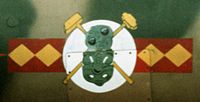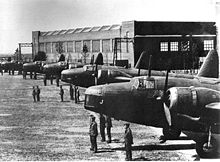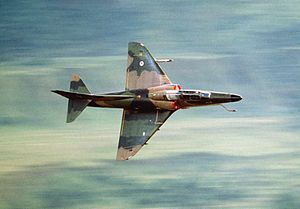- No. 75 Squadron RNZAF
-
No. 75 Squadron Royal New Zealand Air Force
Squadron emblem on A-4K, 1982Active 1946-2001 Country  New Zealand
New ZealandAllegiance  New Zealand
New ZealandBranch  Royal New Zealand Air Force
Royal New Zealand Air ForceRole Bomber
Fighter-attackGarrison/HQ RNZAF Base Ohakea No. 75 Squadron RNZAF was an air combat squadron of the Royal New Zealand Air Force. It was formed from the RAF's World War II bomber squadron, No. 75 Squadron, which had been initially equipped by the New Zealand government and was largely manned by New Zealanders. The squadron was created when, in a unique gesture, the squadron number, colours and battle honours were transferred to the RNZAF in 1946. It had flown more sorties and suffered more casualties than any other in the European theatre.
The squadron ceased to exist on 13 December 2001, when the RNZAF Air Combat Force, comprising Nos 2, 14, and 75 Squadrons, was officially disbanded.
Contents
History
Vickers Wellington bombers of the RNZAF in England, 1939
No. 75 Squadron Royal Flying Corps (later RAF) was formed as a home defence fighter unit in World War I but disbanded at the end of the war. The squadron reformed at Driffield on 15 March 1937 as part of the RAF expansion in the mid 1930s, with transfer of pilots from No. 215 Squadron RAF, being equipped with four Vickers Virginias and seven Avro Anson for bomber training. The squadron later operated Handley Page Harrows which were replaced by Ansons in 1939, operating again in a training role alongside No 15 Operational Training Unit. Meanwhile, the New Zealand government had ordered 30 modern Vickers Wellington bombers to replace its Vickers Vildebeests. Aircrew were sent to England to train on these new aircraft before flying them back to New Zealand. They and their aircraft were attached to 15 OTU.
75 (NZ) Squadron
Short Stirling AA-C
In August 1939, with war seeming increasingly likely, the New Zealand government offered to lend Britain both men and machines. These took over the "75" squadron number, the letters (NZ) being added in brackets afterwards.
75 was the first of the "brackets" squadrons. Ultimately, six other New Zealand units, as well as Australian, Belgian, Canadian, Czech, French, Greek, Hong Kong, Indian, Norwegian, Polish and South African squadrons were formed within the RAF, until the practice ceased in 1942. These squadrons were usually formed around aircrews from the named nation, replacement aircrew where possible coming from that nation as well, although most ground crew were British. Although often referred to, then and since, as an RNZAF unit, 75 squadron was equipped and controlled by the RAF until VJ day.
World War II
Main article: No. 75 Squadron RAF75 Squadron saw action early over France, Norway and most other European nations, but principally against Germany. The squadron was progressively equipped with Short Stirlings, Avro Lancasters, Wellington Bombers and then Avro Lincolns, which it was preparing to take to the Far East as part of Tiger Force when Japan surrendered. The squadron won a single VC, awarded to Sergeant James Allen Ward for climbing along the wing of a Wellington, in flight, to put out an engine fire. 75 Squadron claims to be the only squadron engaged constantly against Germany from 1939 to VE day. The squadron flew more sorties than any other RAF heavy bomber unit, and suffered more casualties than any other squadron. It dropped the second-largest weight of bombs.
An unusual sortie for 75 Squadron was the high altitude run over The Hague in March 1945 by a lone Lancaster piloted by Flight Lieutenant H W Hooper. He dropped thousands of leaflets containing an apology from the British government for the earlier Allied bombing of the city which had been an error.
In March 1944, No. 75 began to exchange its Stirlings for Lancasters and was ready in time to participate in preparation and support of the Allied invasion, the bombing of flying-bomb sites and close-support of the armies. Here it may be mentioned that a Lancaster of the squadron (ND917, a Mark III, captained by Squadron Leader NA Williamson, RNZAF) was, on 30 June 1944, the first British heavy bomber to land in Normandy after the invasion began. The Lancaster was returning from an attack on Villers Bocage in support of the Army and the pilot brought it down on one of the new landing strips in the beach-head in order to seek medical aid for his flight engineer, who had been wounded by flak.
TA-4K at Whenuapai in the late 1980s
75 Squadron RNZAF
In recognition of their wartime record, in October 1946 the RAF officially handed over the 75 Squadron title and badge to the RNZAF. This is the only occasion that the RAF has “gifted” a Squadron title and badge to another Commonwealth Air Force and is a tribute to the sacrifices and contribution made by all New Zealanders in the RAF during World War II.
The post-World War II squadron reformed at RNZAF Base Ohakea and re-equipped, initially with twin-engine de Havilland Mosquito fighter/bombers. In February 1958 Her Majesty Queen Elizabeth the Queen Mother presented No 75 Squadron with its Squadron Standard, the squadron having earned the Sovereign's appreciation for outstanding service. Fourteen Battle Honours were awarded, eight of which are depicted on the Standard.
The unit operated de Havilland Vampires from 1951 to 1970 out of Ohakea.
From 1958 to 1962 the squadron operated nine English Electric Canberras, on loan from the RAF, out of RAF Tengah, Singapore. They were used on anti-terrorist operations during the Malayan Emergency.
In 1970 ten A-4 and 4 TA-4 Skyhawks were purchased and allocated to the squadron which was the primary attack squadron for the RNZAF. Early in their life all of the aircraft were modified with cranked refuelling probes. The Skyhawk fleet underwent Project KAHU in the late 1980s, which upgraded the avionics systems. The squadron's former Royal Australian Navy A-4G aircraft were then re-designated A-4K/TA-4K. The Skyhawks were taken out of service when the squadron was disbanded in 2001.
For many years squadron aircraft would routinely deploy to Clark Air Base, in the Philippines to exercise with the United States Air Force as part of Exercise Cope Thunder, and additionally there was for many years a routine deployment to Malaysia named Exercise Vanguard. Skyhawks were first deployed for 'Vanguard' in 1971 and deployed until 1999 and probably afterwards.[1]
Disbandment
The RNZAF Air Combat Force, comprising Nos 2, 14, and 75 Squadrons, was officially disbanded on 13 December 2001. The disbandment day parade marched the three squadron standards to the Base Ohakea chapel of St Mark and were laid up there to hang from the rafters, until such time as the squadron/s are reinstated.
A political group of concerned civilians and ex-serviceman, called "Save Our Squadrons,(SOS)" was formed to protest the move, and took high court action in an attempt to prevent its loss. The court action was not successful. The New Zealand National Party at the time had promised to re-establish an air combat force if it was re-elected, however in later years statements from their defence spokesperson suggested the cost to do so might be prohibitive. In November 2008, the Labour Government was defeated by the National Party led by John Key. Reinstatement of the air combat capability is very unlikely, although it has been discussed in the media from time to time.
Media
A Squadron History by Norman Franks was published in 1991, titled Forever Strong (a translation of the squadron's Maori motto, Ake Ake Kia Kaha). A pictorial history of the final days of 2, 14 and 75 Squadron has been published, as has a children's book about a Skyhawk serving with the squadron. Aircraft of the Squadron featured in the film Sleeping Dogs and the Disney movie The Rescue.
The National Archives schools web-site features an interview with Gordon Ford, a British wireless operator who served with 75 Squadron.[1]
Preserved aircraft
A Vampire FB Mk.9 at the Museum of Transport and Technology (MoTaT) in Auckland, which never flew with the RNZAF in NZ but was used as a painting dolly, has 75 Squadron markings presumably painted by trainees at an RNZAF Station, alongside an ex-French Navy Avro Lancaster that has been restored and is wearing 75 Squadron colours on one side, and the colours of an RAF squadron with New Zealand aircrew on the other side. In a restoration hangar nearby is a de Havilland Mosquito formerly used by the squadron, which is being restored for display. A TA4 Skyhawk 'replica' assembled from parts in the late 90's at Ohakea and carrying the ficticous tail number of NZ6257 also carries 75 SQN low visibility markings on one side, with 2 SQN markings on the other. This is the scheme applied to all Skyhawks in the late 90's to 2001, to simplify the rotation of aircraft between 75 Sqn at Ohakea and 2 Sqn at NAS Nowra. This aircraft was positioned outside the Ohakea Museum, but when the Museum was closed in 2007, the replica TA4 was moved into storage at Ohakea. Another Skyhawk in 75 Squadron markings is preserved (in the original RNZAF A4 colour scheme, circa early 1970s) at the Royal New Zealand Air Force Museum at Wigram - originally an early model US aircraft, this was gifted to NZ by an American movie company and assembled by the museum with straight refuelling probe and typical bomb and missile load for display. Hanging from the roof alongside is a De Havilland Vampire FB5 in 75 Squadron colours.
In December 2001, the Air Combat Force of the RNZAF, comprising 2, 14 and 75 Squadrons was closed down, the squadrons disbanded, and the aircraft put up for sale. Since 2002, several private US flight training firms have undertaken due diligence and negotiations to purchase the 17 surviving T/A4K aircraft and the 17 Aermacchi MB339CB's as a package deal. The MB339's have been kept in flying condition by a contracted civilian company using personnel made redundant in 2001 at RNZAF Base Ohakea, however the Skyhawks have been stored in an outside location covered in a latex film at RNZAF Base Woodbourne. If the aircraft are eventually sold, most of the Skyhawks will require major refurbishment to regain flying condition. The national markings will have to be removed, but it has been mentioned that it is intention of at least one buyer to retain the squadron badges and colour schemes "to preserve the traditions of the RNZAF". On the 7 October 2009, the sale was confirmed to have been completed.
75 Squadron Association of New Zealand
The 75 Squadron Association of New Zealand, was created in 1955 to maintain the comradeship and associations that have been made through membership of 75 Squadron RAF, 75(NZ) Squadron RAF, and 75 Squadron RNZAF. It also was to maintain a link with between all former members of "75 Squadrons" and "75 Squadron Associations", both in NZ and overseas.
The 75 SQN Association NZ is currently assembling the history of 75 Squadron from 1916 to 2001 for publication in two Volumes that includes stations, bases, countries, battles, honours, aircraft and listing all personnel.
References
Bibliography
- Norman L. R Franks Forever strong: The story of 75 Squadron RNZAF, 1916–1990, Random Century 1991. ISBN 978-1869411022
External links
Categories:- Royal New Zealand Air Force squadrons
- Military units and formations of the RNZAF in World War II
Wikimedia Foundation. 2010.






